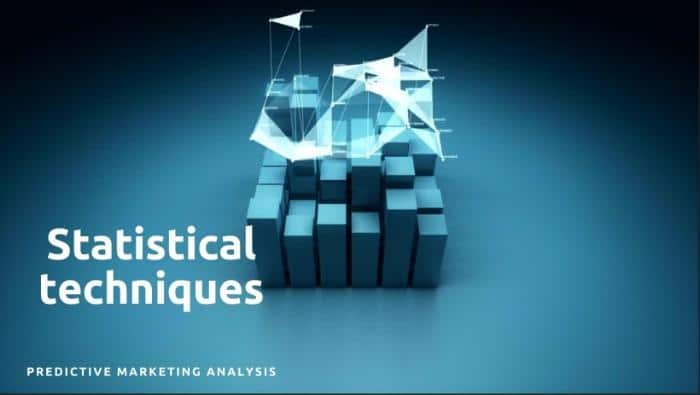Predictive Analytics In Marketing: What It Is & How To Use It

Predictive analytics is a powerful tool that can help marketing professionals more effectively target their audiences and measure the effectiveness of their campaigns.
By using predictive analytics, marketing professionals can develop more accurate models of customer behavior, identify key trends and patterns, and make more informed decisions about where to allocate resources.
Predictive analytics can also help marketers better understand the impact of marketing campaigns on customer behavior and identify opportunities for optimization.
Predictive analysis has been a game-changer for marketing, and in this article, we will explore how and why.
Let’s dive into the subject.
What is predictive analytics?

In a nutshell, predictive analytics is a type of data analysis that uses historical data to make predictions about future events.
Predictive analytics models are based on statistical and machine learning techniques, and they can be used to identify patterns and trends in data.
How can predictive analytics help marketing professionals?

Predictive analytics can help marketing professionals in a number of ways. First, predictive analysis in marketing can be used to develop more accurate models of customer behavior.
This information can then be used to target audiences more effectively and measure the effectiveness of marketing campaigns.
In addition to this, predictive analytics can assist marketers in spotting vital customer behavior trends and patterns, allowing for more resourceful decisions about where to allocate their resources.
For example, let’s say a company is considering running a television ad during primetime. By using predictive modeling, they can evaluate data on past customer behavior to determine whether or not running an ad during that time slot would be effective.
This type of analysis can help companies make more informed decisions about how to allocate their resources.
A parallel example, in 2016, the Obama campaign used predictive analytics to great effect. By analyzing data on past voting behavior, they were able to identify which voters were most likely to respond positively to their message and tailor their campaign accordingly.
By using predictive analytics, the Obama campaign was able to target its message more effectively and ultimately secure a victory.
How can marketers use predictive marketing analytics to improve their campaigns?
Marketers Can Use Predictive Analytics To Improve Their Campaigns In A Number Of Ways.
First, predictive analytics can be used to develop more accurate models of customer behavior.
Second, predictive analytics can help marketers identify key trends and patterns in customer behavior, and make more informed decisions about where to allocate resources.
It has been estimated that predictive analytics can help organizations achieve a 19% increase in accuracy when targeting individuals for marketing campaigns. (Forrester, 2016)
Furthermore, when used to its full potential, it has been reported that predictive analytics can add $10 million per year for every 1% increase in response rates to direct marketing efforts. (Gartner, 2010)
Looking at these figures alone, it’s easy to see that predictive analytics is a powerful tool that can have a significant impact on an organization’s bottom line.
Marketing professionals who are not using predictive analytics are at a competitive disadvantage to those who are.
What are some of the challenges associated with using predictive marketing analytics?

The main challenges associated with using predictive analytics in marketing are data quality and inaccuracy, lack of expertise and experience, and the need for specialized software.
Data quality and inaccuracy can be a challenge because the models used in predictive analytics are often based on historical data that may not be accurate or representative of current customer behavior.
Lack of expertise and experience can be a challenge because developing accurate models requires understanding the underlying data and using the correct algorithms and techniques.
Many predictive analytics models require specialized software, which can present a challenge for users.
Nevertheless, these days are available a lot of sources for specialized pieces of training so this challenge can be overwhelmed quite easily.
Statistical techniques used in predictive marketing analysis

Predictive analytics uses a variety of statistical techniques, including regression analysis, decision trees, and neural networks.
Each of these techniques helps marketers to understand different aspects of consumer behavior so that they can better predict how consumers will respond to future marketing campaigns.
1. Regression analysis

One common technique is regression analysis, which can be used to identify relationships between different factors and predict future outcomes.
This technique is often used in marketing to predict things like future sales, customer behavior, and response rates.
Regression analysis can be used to identify which factors are most important in predicting the desired outcome, and then create models that target those factors. This approach can be useful in situations where there is a lot of data available and can help marketers focus their efforts on the most important factors.
2. Decision trees

Another technique is decision trees, which can be used to create models that predict how a customer will behave. Decision trees work by looking at a series of data points and making predictions based on which path the customer is most likely to take.
Let’s say you’re trying to predict whether or not a customer will buy a product. You would start by looking at a series of data points, such as the customer’s age, gender, location, and purchase history.
Based on these data points, you would then create a series of questions that would help you predict whether or not the customer is likely to buy the product. For example, you might ask: Is the customer male or female? If female, is she between the ages of 18 and 24? If yes, is she located in the United States? If the answer to all of these questions is yes, then there’s a good chance that the customer will buy the product.
3. Neural networks

Finally, neural networks can be used to create models that learn from past data in order to make predictions about the future. Neural networks are similar to decision trees in that they can be used to model non-linear relationships. However, neural networks are more flexible than decision trees and can learn more complex patterns.
By using these different statistical techniques, businesses can get a better understanding of what trends are likely to occur in the future and adapt their marketing plans accordingly.
3 types of prediction models used in marketing
There are many different types of predictive analytics tools available, but some of the most popular include market mix modeling, customer lifetime value analysis, and campaign attribution modeling.
Marketers can use these tools to develop more accurate models of customer behavior, identify key trends and patterns, and make more informed decisions about where to allocate resources.
1. Market Mix Modeling
One popular technique for predictive analytics in marketing is called market mix modeling (MMM).
MMM is a statistical tool that analyzes sales data points to determine the most effective combination of marketing variables – such as advertising, promotions, and pricing – for a product or service.
MMM can be used to optimize an existing marketing campaign or to design a new one from scratch.
It can also be used to assess the impact of changes in the marketing mix on sales—for example, to determine how a change in advertising spending will affect sales.
2. Customer Lifetime Value Analysis
Customer lifetime value (CLV) is a metric that represents the total amount of money a customer is expected to spend on your product or service over the entire course of their relationship with your business.
This number can be used to help inform marketing decisions, such as how much to spend on acquiring new customers or retaining existing ones.
CLV can also be used as a metric to compare the value of different segments of customers.
For example, a business might find that its most valuable customers are those who have been with the company for more than five years.
This information can then be used to target marketing efforts toward retaining these long-term customers.
There are a variety of methods for calculating CLV, but the most important part is understanding how this metric can be used to inform your business decisions.
3. Campaign attribution modeling
This is a type of predictive model used in marketing to assign a value to each touchpoint in the customer journey, in order to credit each touchpoint with its contribution to the final outcome.
What does it mean? It’s important to understand that this type of modeling can be helpful for understanding which marketing channels are most effective, in order to develop an efficient marketing strategy.
There are a variety of different campaign attribution models, each with its own strengths and weaknesses.
The most important thing is to choose the model that best fits your data and your business goals.
With the right campaign attribution model in place, you can start to get a better understanding of your marketing campaigns and how they impact your bottom line.
Takeaways (Best Practices)
If you’re interested in using predictive analytics in your marketing, there are a few things you can do to get started.
- First, focus on the goals and objectives that you want to achieve with your predictive analytics efforts. What do you hope to learn or accomplish?
- Second, make sure you have high-quality data that is relevant to your predictive analytics goals.
- Third, choose the right predictive analytics model or technique for your needs.
- Fourth, don’t forget to monitor and evaluate your results regularly to ensure that your predictive analytics efforts are paying off.
After your model is trained, you can begin using it to make predictions about future customer behavior. By following these best practices, you can make sure that you’re getting the most out of predictive analytics.
How will predictive analytics change marketing in the future?
Predictive analytics is already having a significant impact on marketing, and this impact is only likely to increase in the future.
As predictive analytics becomes more popular, it is likely that marketing will become more data-driven.
Organizations will become more focused on using marketing data to measure the results of their campaigns and make decisions about where to allocate resources.
Additionally, predictive models will likely play a role in automated marketing, as organizations use data to automatically target and reach audiences with personalized messages.
FAQ
What is predictive analytics?
Predictive analytics is the use of data, statistical algorithms, and machine learning techniques to identify the likelihood of future outcomes based on historical data.
How is predictive analytics used in marketing?
Predictive analytics can be used in marketing to identify patterns and trends in customer behavior, segment customers, and predict future customer behavior.
Predictive analytics can also be used to develop marketing campaigns that are targeted and personalized to individual customers.
What are some of the benefits of using predictive analytics in marketing?
Some benefits of using predictive analytics in marketing include the ability to make more informed decisions about marketing campaigns, better target customers, and improve customer retention.
What are some of the challenges of using predictive analytics in marketing?
Some challenges of using predictive analytics in marketing include data quality issues, the need for skilled personnel, and a lack of understanding of the technology.
How can predictive analytics be used to measure marketing ROI?
There are a variety of ways to use predictive analytics to measure marketing ROI.
One common method is to track the number of leads generated from each marketing campaign and analyze the conversion rate of those leads into customers.
This data can then be used to calculate the overall ROI for each marketing campaign.
Other ways to use predictive analytics for marketing ROI include tracking the number of website visitors, analyzing customer buying patterns, and measuring customer satisfaction levels.
If you’re interested in learning more about predictive analytics, here are a few articles on this blog to continue:

About the Author
Liviu Prodan
Liviu is an experienced trainer and LifeHacker. He’s been living the ‘Corpo life’ for more than 15 years now and has been a business developer for more than 12 years. His experience brings a lot of relevancy to his space, which he shares on this blog. Now he pursue a career in the Continuous Improvement & Business Development field, as a Lean Six Sigma Master Black Belt, a path that is coherent with his beliefs and gives him a lot of satisfaction.










